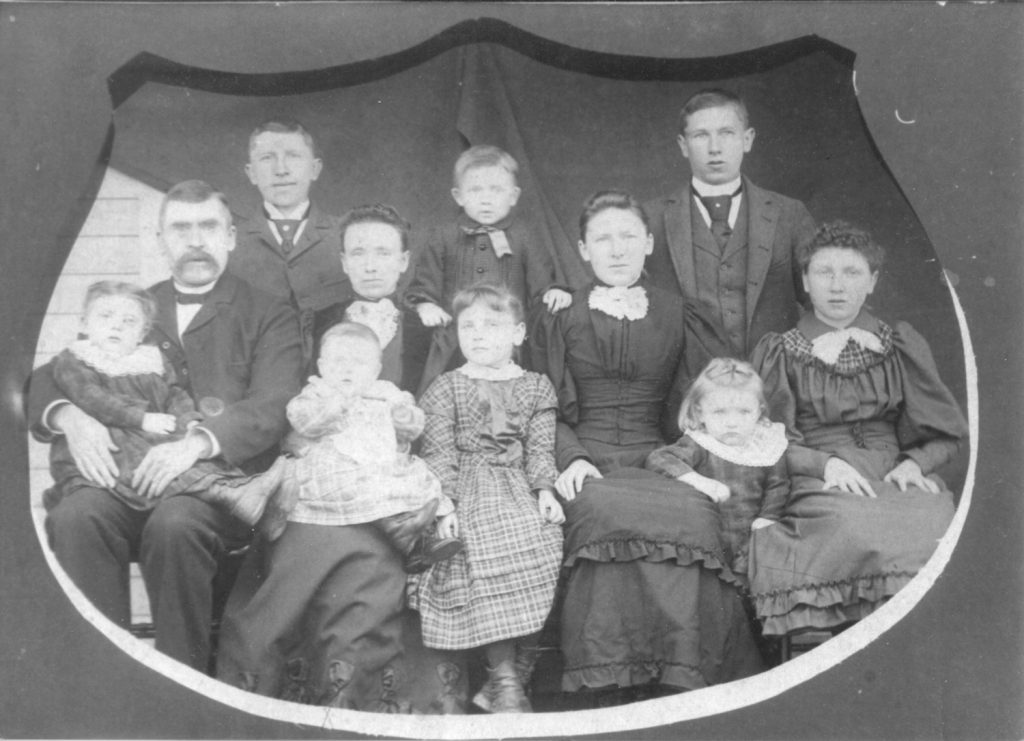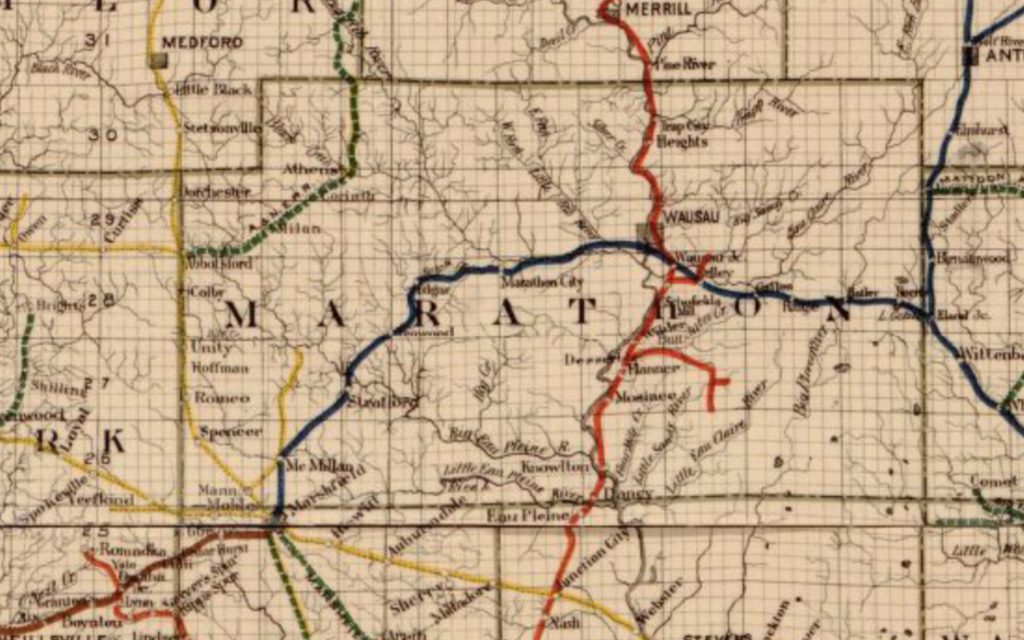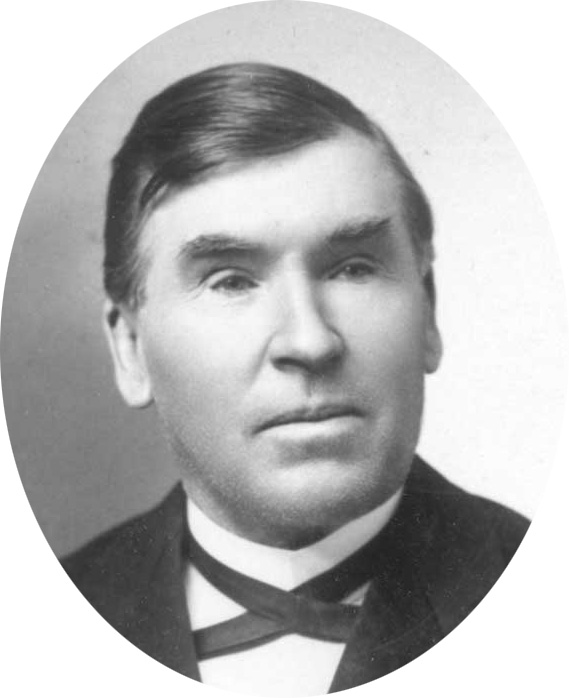
On this day 127 years ago, my great-great-grandfather, 43-year-old Alfred Cook, arrived in Marshfield in time to catch the 6:15 train bound for Wausau. September 26, 1893, was a Tuesday, and Alfred, chairman of the Town of Brighton, he was on his way to attend the meeting of the county board of Marathon county. Living in Unity, Marathon County, he would have been up extraordinarily early to travel the approximately 15 miles to Marshfield. Did he travel by train on the Wisconsin Central, [1] or did he travel by horse and buggy?
On this day the way freight on the Milwaukee Lake Shore railway to Wausau was made up of eighteen freight cars. Alfred, along with the Rev. James Brown, Christ Vogt, and Conductor Dunn, settled in for the trip riding in the caboose.
“Just before reaching McMillan there is a steep grade. When the last section of the train was nearly to the top a coupler broke, leaving a portion of the train to follow. None of the train men were aware of the break and when the forward section reached McMillan about three quarters of a mile distant, it pulled up at the station. Without warning, the last section came tearing down upon them gaining speed at every revolution of the wheels.” “The two sections came together with a crash, throwing one car from the track and the passengers across the caboose, badly bruising them all.” The sentence goes on to say, “and probably fatally injuring Mr. Cook, who struck the water cooler with his head, causing concussion of the brain.” [2]

“The wounded men were brought back to this city [Marshfield] and medical aid summoned. With the exception of Mr. Cook, the injuries to the others are slight beyond a bad shaking up and more or less bruised. Mr. Cook was first taken to the hospital, but as that institution is full of patients, he was taken to the Tremont house where he now lies” and was seen by Dr. Budge, and the railroad’s chief surgeon, Dr. J. F. Pritchard. “Mr. Cook’s wife, relatives and friends came down from Unity on the first train and are doing all they can for him. [3] Alfred’s sister Kate and his brother-in-law Conner Healy accompanied Amanda and their eldest son, Herbert, to Marshfield. I can only imagine what they were thinking as they rode the 15 miles from Unity to the Tremont House in Marshfield. [4]
“Between Life and Death. Alfred Cook, of Unity, Lies in a Precarious Condition at the Tremont.” reads the headline of The Marshfield News the next day. The newspaper reported that he had not yet regained consciousness, and was delirious. [5] His condition did not improve over the next few days as newspapers around the state reported that “should he recover, he will be disabled for life and total blind.” [6]
The Cook family brought Alfred home to Unity on Friday, September 29th. At that time he was still in “an unconscious condition, but on Saturday he regained consciousness. He knew all who spoke to him but could not see them.” [7]
S. A. Cook left Neenah, Winnebago County for Unity on Wednesday, October 4th to visit his brother. The Neenah Daily Times reported that “Mr. Cook is recovering slowly but has not regained his sight. He is occasionally delirious, from the blow on his head, the only external mark of which is a bruise about the size of a quarter. He imagines that he is still under the car and continually pleads that his companion (who was but slightly hurt) [he is most likely referring to Chris Vogt who was also on his way to the county board meeting] be taken out quickly. ‘He is worse hurt than I am and I can wait,’ is the constant cry which shows the nature of the man. He thinks they have been under the car three weeks, and protests against the delay and darkness, which he attributes to bad management on the part of the railroad company. He does not realize that he is blind and frequently asks why lanterns are not procured.” [8] He was also imagining that the “car was settling down upon him and struggles to hold it up until he sinks back exhausted. At such times he has to be held in bed.” [9]
Friday, October 6th he was again seen by Dr. Budge and Dr. Pritchard, joined by Prof. John E. Owen, chief surgeon of the Chicago Northwestern Railway, Dr. Tilly a “celebrated eye surgeon of Chicago,” and B. A. Little, traveling claim agent. These men examined and consulted on Alfred’s case, deciding to wait two weeks longer, “after which if he does not regain his sanity and sight an operation will be performed.” [10] Upon examining him, Dr. Tilly decided that “there is no injury to the globe of the eye, the optic nerve or the optic track, to cause his blindness, and hence it must be in the visual center, located in the occipital lobe of the brain and that there is pressure on the brain, either from fracture of the skull or from blood clots lying underneath the skull. He advised an exploratory incision through the scalp to ascertain if the skull was fractured, but as Mr. Cook has improved generally so rapidly, although he is totally blind, his friends would not consent to an immediate operation.” [11]
By the time the Appleton Weekly Post went to press on October 12th, Alfred was improving slowly, being conscious part of the time, but “still has fits of delirium and violence, and is still totally blind.” [12] His condition was still critical a month after the accident, and “Drs. Owen and Pritchard of the Northwestern road, Dr. Badger, of Marshfield, Dr. Barnett of Neenah and Dr. Reeve” of Appleton arrived to again examine him and consult as to whether or not an operation should be performed. [13] The Marshfield Times reported the next day, October 27th that an operation would be performed.
Friday, October 13th, S.A. again traveled to Unity to be by his brother’s side. [14] The next day word was received in Appleton that Alfred “was sinking.” “The physicians have decided that an operation must be performed to remove a sliver of bone which they think is resting on the brain.” [15] Alfred was now totally paralyzed on the left side. I am sure that Jacob caught the next train to Unity to join S.A. at Alfred’s side, and to be a support to their sister-in-law, Amanda. I have been unable to find news of the operation taking place, so I am doubtful that they went forward with the plan to operate.
Two months after the accident on November 30th, The Marshfield Times reported that he is finally regaining some of his eyesight, and is feeling much better. [16] Alfred was definitely feeling better, as, accompanied by his son Herbert, he “visited friends in Marshfield on December 15th, and plans were being made that he, accompanied by Herbert, would go south for the “months of January and February.” [17]
Christmas night Alfred, accompanied by Herbert, left for Hot Springs, Arkansas, “where he hopes to regain his sight and also his mental equilibrium.” He was still having “occasional flighty spells, and his sight is totally lacking.” [18]
The Appleton Weekly Post reported the first news of the fact that Alfred sued the railroad (I am hoping to scope out details). The paper reported that “about December 11th” [19] he had “made a settlement with the railroad company on terms perfectly satisfactory to his family and friends, but in deference to the wishes of all concerned, the amount is not made public.” [20]
Alfred and Herbert returned to Wisconsin earlier than originally reported, as the news was published that they had made a stop in Appleton the last week of January to visit with his brother, Jacob, and his family. The time away did much to improve his health, but he had not yet “recovered his sight.” [21]
The last news we have of Alfred’s condition was published in the Marshfield Times on April 20, 1894. The article reports the news that Alfred’s character and honesty had come into question, as it states “After his return [from his trip to Hot Springs] it was rumored that Mr. Cook had regained his eyesight suddenly and was nearly as well as ever, casting reflections on him that he had been playing possum with the railway company, that as soon as he received the money his eyesight returned very rapidly.” The article starts with a quick recap of the events. “It will be remembered that Mr. Cook from the effects of the injury was totally blind in both eyes, with a loss of sensation in the whole right half of the body and an impairment of motion in the same. After several weeks his physicians discovered he could detect a little light in the right half of both eyes, but the other half of both eyes were totally blind.” It continues “Now the facts are that to-day the one-half of each eye that he detected light soon after the injury, has so far improved that he is able to see to go around but the other half of each eye is totally blind the same as after the injury and it is believed will remain so the remainder of his life.” The railroad company was “very thankful that he can see sufficiently so he is able to go around without a guide and they believe there is no man that would be willing to be placed in Mr. Cook’s condition for the amount of money received.” [22]
While this story is remarkable just as it is told, what has struck me is that this story was not passed down from generation to generation. Scanning a newspaper website in November 2006 I came across an article titled “Railway Wreck Near Marshfield” that contained the search term “Alfred Cook, of Unity,” [23] I questioned whether or not this was “my” Alfred Cook, of Unity, as I had not heard of the accident, or that he was partially blind. It took finding the papers that also included the names of his brothers, that I knew that is was “my” ancestor.
Alfred was still very ill one week later when on October 4th he celebrated his 44th birthday. He was still a young man, a man who had a very young family at home, as he had recently become a father for the tenth. His wife, Amanda Melinda Blood Cook, age 40, had given birth to Raymond Donald on May 1st. At the time of the accident, this little boy was almost 5 months old. The rest of the children ranged in age from 19 to 2 years old.
Their eldest child, Herbert Alfred, was 19 years old. George Sewell had turned 17 just 11 days before the accident, and my great-grandfather, Lewis Herman was 16. The rest of the children were: Henrietta – 15, Mabel – 12, Emelyn was seven, as she had celebrated her birthday on September 3rd, Walter – 4, Edith – 3, and Ella, who turned 2 years old two days after the accident on September 28th. While only a handful of these people lived into my lifetime, seven of them saw my father grow into adulthood. The longest living was Raymond, whose son Rod was instrumental in keeping the Cook traditions and stories alive. Except for this one.
Alfred died on January 30, 1921, he was 70 years old. After the accident, he continued to live a full and active life.
How this story was lost, we may never know.
Sources:
- Railroad Commission Of Wisconsin, and Graham L Rice. Official railroad map of Wisconsin. [Madison, Wis.: Railroad Commissioner, 1900] Map. Retrieved from the Library of Congress, www.loc.gov/item/2006629781/; accessed 17 Jul 2020.
- “A Broken Coupler,” The Marshfield Times, 29 Sep 1893, Friday, p. 1, col. 1; digital images, NewspaperARCHIVE.com (www.newspaperarchive.com : accessed 12 Dec 2007).
- Ibid.
- “Unity Items.,” The Marshfield News, 5 Oct 1893, Thursday, p. 8, col. 2; digital images, Newspapers.com (www.newspapers.com : accessed 27 Mar 2017).
- “Between Life and Death,” The Marshfield News, 28 Sep 1893, Thursday, p. 1, col. 6; digital images, Newspapers.com (www.newspapers.com : accessed 24 Mar 2017).
- The Neenah Daily Times, 2 Oct 1893, Monday Evening, p. 4, col. 2; digital images, Newspapers.com (www.newspapers.com : accessed 24 Mar 2017).
- “Unity Items,” The Marshfield News, 5 Oct 1893, Thursday, p. 8, col. 2; digital images, Newspapers.com (www.newspapers.com : accessed 27 Mar 2017).
- “A Terrible Sufferer,” The Neenah Daily Times, 4 Oct 1893, Wednesday Evening, p. 1, col. 5; digital images, Newspapers.com (www.newspapers.com : accessed 24 Mar 2017).
- “Curious Effects of a Slight Hurt,” Wisconsin State Journal, 17 Oct 1893, Tuesday, p. 2, col. 5; digital images, Newspapers.com (www.newspapers.com : accessed 24 Mar 2017).
- “Alfred Cook’s Condition,” Appleton Weekly Post, 12 Oct 1893, Thursday, p. 5, col. 5; digital images, Newspapers.com (www.newspapers.com : accessed 24 Mar 2017).
- The Marshfield News, 12 Oct 1893, Thursday, p. 4, col. 2; digital images, Newspapers.com (www.newspapers.com : accessed 24 Mar 2017).
- “Improving Slowly,” Appleton Weekly Post, 12 Oct 1893, Thursday, p. 6, col. 5; digital images, Newspapers.com (www.newspapers.com : accessed 24 Mar 2017).
- “Condition of Alfred Cook,” 26 Oct 1893, Thursday Evening, p. 4, col. 3; digital images, Newspapers.com (www.newspapers.com : accessed 24 Mar 2017).
- The Neenah Daily Times, 13 Oct 1893, Friday Evening, p. 4, col. 3; digital images, Newspapers.com (www.newspapers.com : accessed 24 Mar 2017).
- “Growing Worse,” Appleton Crescent, 14 Oct 1893, p. 5, col. 1; digital images, Newspapers.com (www.newspapers.com : accessed 24 Mar 2017).
- The Marshfield News, 30 Nov 1893, Thursday, p. 8, col. 2; digital images, Newspapers.com (www.newspapers.com : accessed 24 Mar 2017).
- “Unity,” The Marshfield News, 21 Dec 1893, Thursday, p. 8, col. 3; digital images, Newspapers.com (www.newspapers.com : accessed 27 Mar 2017).
- “Gone to Hot Springs,” Appleton Weekly Post, 28 Dec 1893, Thursday, p. 1, col. 3; digital images, Newspapers.com (www.newspapers.com : accessed 27 Mar 2017).
- “Mr. Cook’s Condition. The Unity Man who was Injured in the McMillan Railroad Accident.,” The Marshfield Times, 20 Apr 1894, Friday, p. 1, col. 4; digital images, NewspaperARCHIVE (www.newspaperarchive.com : accessed 12 Dec 2007).
- Ibid.
- Appleton Weekly Post, 1 Feb 1894, Thursday, p. 5, col. 3; digital images, Newspapers.com (www.newspapers.com : accessed 27 Mar 2017).
- “Mr. Cook’s Condition. The Unity Man who was Injured in the McMillan Railroad Accident.”
- “Railway Wreck Near Marshfield,” The Marshfield Times, September 30, 1893, p. 3, col. 3; digital images, NewspaperARCHIVE (www.newspaperarchive.com : accessed 20 Nov 2006).

